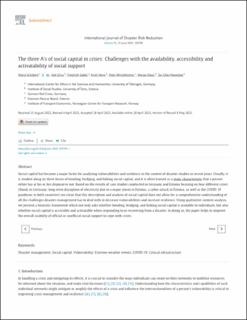| dc.contributor.author | Schobert, Maira | |
| dc.contributor.author | Orru, Kati | |
| dc.contributor.author | Gabel, Friedrich | |
| dc.contributor.author | Nero, Kristi | |
| dc.contributor.author | Windsheimer, Peter | |
| dc.contributor.author | Klaos, Margo | |
| dc.contributor.author | Nævestad, Tor-Olav | |
| dc.coverage.spatial | Oslo, Norway | en_US |
| dc.date.accessioned | 2023-06-15T06:46:02Z | |
| dc.date.available | 2023-06-15T06:46:02Z | |
| dc.date.created | 2023-05-04T13:22:10Z | |
| dc.date.issued | 2023-04-28 | |
| dc.identifier.citation | International Journal of Disaster Risk Reduction. 2023, 92 (June 2023), 1-14. | en_US |
| dc.identifier.uri | https://hdl.handle.net/11250/3071465 | |
| dc.description | Maira Schobert, Kati Orru, Friedrich Gabel, Kristi Nero, Peter Windsheimer, Margo Klaos, Tor-Olav Nævestad, The three A's of social capital in crises: Challenges with the availability, accessibility and activatability of social support, International Journal of Disaster Risk Reduction, Volume 92, 2023, 103704, ISSN 2212-4209, https://doi.org/10.1016/j.ijdrr.2023.103704.(https://www.sciencedirect.com/science/article/pii/S221242092300184X) | en_US |
| dc.description.abstract | Social capital has become a major factor for analysing vulnerabilities and resilience in the context of disaster studies in recent years. Usually, it is studied along its three forms of bonding, bridging, and linking social capital, and it is often framed as a static characteristic that a person either has at his or her disposal or not. Based on the results of case studies conducted in Germany and Estonia focusing on four different crises (floods in Germany; long-term disruption of electricity due to a major storm in Estonia; a cyber-attack in Estonia; as well as the COVID-19 pandemic in both countries) we claim that this description and analysis of social capital does not allow for a comprehensive understanding of all the challenges disaster management has to deal with to decrease vulnerabilities and increase resilience. Using qualitative content analysis, we present a heuristic framework which not only asks whether bonding, bridging, and linking social capital is available to individuals, but also whether social capital is accessible and activatable when responding to or recovering from a disaster. In doing so, the paper helps to improve the overall usability of official or unofficial social support to cope with crises. | en_US |
| dc.description.abstract | The three A's of social capital in crises: Challenges with the availability, accessibility and activatability of social support | en_US |
| dc.language.iso | eng | en_US |
| dc.publisher | Elsevier | en_US |
| dc.rights | Navngivelse 4.0 Internasjonal | * |
| dc.rights.uri | http://creativecommons.org/licenses/by/4.0/deed.no | * |
| dc.title | The three A's of social capital in crises: Challenges with the availability, accessibility and activatability of social support | en_US |
| dc.title.alternative | The three A's of social capital in crises: Challenges with the availability, accessibility and activatability of social support | en_US |
| dc.type | Journal article | en_US |
| dc.type | Peer reviewed | en_US |
| dc.rights.holder | © 2023 Published by Elsevier Ltd | en_US |
| dc.source.articlenumber | 103704 | en_US |
| dc.description.version | publishedVersion | en_US |
| cristin.ispublished | false | |
| cristin.fulltext | original | |
| cristin.qualitycode | 1 | |
| dc.identifier.doi | 10.1016/j.ijdrr.2023.103704 | |
| dc.identifier.cristin | 2145488 | |
| dc.source.journal | International Journal of Disaster Risk Reduction | en_US |
| dc.source.volume | 92 | en_US |
| dc.source.issue | June 2023 | en_US |
| dc.source.pagenumber | 1-21 | en_US |
| dc.relation.project | EC/H2020/833496 | en_US |

